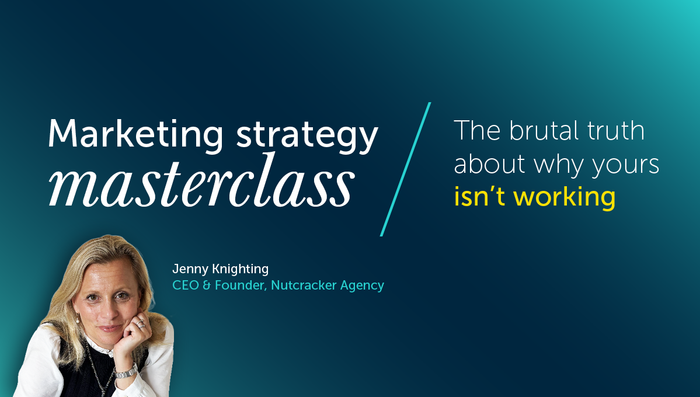Sales & Lead Generation
How to stand out from the crowd and secure market share
TLDR: Summary
To win in a crowded market, you can’t simply be “better”; you have to be different. This guide provides a strategic framework for B2B businesses looking to stand out and secure a competitive advantage. You'll learn how to conduct a competitive analysis, define a unique value proposition, and leverage a consistent brand story to build trust and capture new market share.
The Guide to Standing Out & Securing Market Share
In today's competitive landscape, businesses face a constant battle for attention. It's a race to the bottom for many, as they compete on price and features, all while struggling to differentiate themselves. The truth is, winning new business isn’t about being louder; it's about being more compelling and unique.
Securing market share isn’t about brute force. It's about strategic positioning and building a brand that is so distinct that it creates its own space in the market. Here's how to move from being one of many to the only choice.
Step 1: Know Your Battlefield (Competitive Analysis)
You can't stand out if you don't know who you're standing out from. The first step in any effective marketing strategy is to conduct a thorough competitive analysis.
Create a simple matrix comparing your brand against your top 3-5 competitors. Don't just look at features and pricing. Analyse their brand messaging, tone of voice, content topics, and even their social media presence. Look for the gaps: Are they all targeting the same niche? Are their brands all speaking in a boring, corporate tone? Identifying these gaps is the first step to finding your unique place.
Step 2: Define Your Unique Value Proposition (UVP)
Your brand is your promise, but your Unique Value Proposition (UVP) is the reason a prospect should choose you over anyone else. It's the one thing you do better or differently that solves a specific problem for a specific audience.
Your UVP should be a clear, concise statement that answers the question: "Why should I buy from you?" It's not about being a "better" product. It's about being a different kind of solution. Your UVP is the foundation of every brand message you create.
Step 3: Tell Your Story
With a clear UVP, you can begin to tell a compelling story that resonates with your audience. Storytelling is the most powerful tool you have to stand out from the crowd and build an authentic brand.
In your brand story, your customer is the hero, and your business is the trusted guide. Focus on their challenges, their journey, and how your solution helps them achieve a positive outcome. To learn more about this, check out our guide on B2B brand storytelling.
Don't try to be something you're not. Be honest about who you are, what you stand for, and who you serve. This builds trust and creates a genuine connection with your audience.
The Foundation of a Distinct Brand: "Joined-up" Marketing
Your brand’s message should be consistent across every channel, from your website to your social media. A "joined-up" marketing strategy ensures that your brand’s voice is the same on a paid ad as it is on a blog post or a sales email. This consistency makes your brand more memorable.
Align your sales and marketing teams so they are working toward the same goals. Ensure all brand assets are consistent and easy to access. A unified approach eliminates confusion and makes your brand feel stronger and more reliable. To learn more about this, read our guide on what joined-up marketing is.
Step 4: Measure Your Market Share & Mindshare
How do you know if your efforts are working? You can't manage what you don't measure.
Market share is the percentage of total sales in your industry that your company captures. While this can be difficult to track, you can use sales data and industry reports to get a clear view of your position.
Share of Voice (SOV) is a measure of how much of the conversation in your industry your brand owns. You can use tools like Semrush or Ahrefs to track branded keywords and mentions across the web. A high SOV often correlates with market share gains.
Measuring branded search volume is done by monitoring how many people are searching for your brand name directly. An increase here is a strong indicator of growing brand recognition. To learn more about how to build a memorable brand, read our guide on how to make people remember your brand.
Ultimately, securing market share is about building a brand that is so distinct and valuable that prospects would be foolish to choose anyone else. It's a long-term investment, but one that pays dividends in loyalty and sustainable business growth. For a full breakdown of how to build a winning marketing strategy, explore our B2B Marketing Strategy services.
How to secure market share
Even before you think about the competition for budget, you need the win the competition for attention. That might be the even harder task.
Why? Because the competition for budget is just between you and your competitors. The competition for attention is between you, your competitors, vendors from other sectors, your prospect’s professional obligations, and the pressure on their life outside of work.
It has probably never been harder to earn and keep people’s attention, and that means you need to be much smarter, much more creative, and much more interesting than your competition.
This is your introduction to getting the attention that will grow your brand:
- What resonates with prospects and makes them want to engage with you
- How to make sure your expertise and value stand out in a crowded market
- Why is AI a useful tool for growing your brand (and what you shouldn’t use it for)
How to get leads who are engaged with your brand
It is not difficult to find out what prospects will engage with. In fact, they’re very open about it.
- 80% of customers say they are more likely to purchase from brands that provide personalised experiences (Epsilon)
- 66% of decision makers say they find vendor content ‘biased toward the vendor’ and ‘not objective or balanced’. (Forrester)
Straight away, there are two ways for your brand to stand out:
- Personalise the content or the buyer journey
- Be genuinely valuable — with marketing, ‘selling’ does not sell
61% of decision-makers say thought leadership is more effective than product marketing at demonstrating value (Edelman), so if you’re actually useful, telling them something that they don’t know but will make their job easier, then you are already a trusted partner, worthy of their time and energy.
How to cut through the noise and get your brand noticed
There are two main strands to getting noticed:
- What you present
- How you present it
The brand that you show to your audience has about 50 milliseconds to impress — that’s how long people take to decide whether they like to look of something (CXL).So, your brand needs instant impact — it needs to communicate authority, value and expertise in about half the amount of time it takes to blink (UCL).
However, to even get to the stage at which prospects are seeing you, you need:
- Targeted campaigns that put your brand in front of the right people
- Integrated strategies across social, email, and web to drive visibility
It is not simply a matter of placing your content in front of your targets.It takes 5-7 interactions for a prospect to remember your brand (B2BMarketing.net), so you must
Make sure they see it again and again, and that it is consistent every time they encounter it.
The role of AI in marketing
AI could either enhance your marketing dramatically, or make it absolutely useless, depending how you approach it.
It is an incredibly powerful tool for:
- Personalisation: it can curate experiences and content based on the audience, and as we saw earlier, those personalised experiences mean 80% of customers are more likely to buy
- Automation: it can handle aspects of marketing like email timing and sequences, optimising elements based on performance and target audience
- Analysis: AI can offer much richer insights into the successes, failures, strengths and weaknesses of your strategy and collateral
However, misusing AI can make your marketing weak, generic, and useless.
For example, if you were to rely on generative AI like ChatGPT to produce your content for you, that content would not stand out, resonate or generate leads.
Large Language Models (LLMs) learn from patterns in their training data to produce text that is relevant to a prompt. When it is trained on published materials that means it is replicating common ideas, phrasings, and summaries. All in all, using it to write your content for you is a very quick and efficient way to look and sound like everyone else.
81% of prospects want their supplier, vendor, or partner to be an expert who challenges their assumptions (Edelman). You cannot be that when all you do it aggregate and repeat other people’s ideas.
Your guide to earning attention and securing market share
If you have big ambitions for growth, but you are struggling to get eyes on your brand and attract people to your content, then we have published a guide that will help you to:
- Attract attention
- Build engagement
- Convert leads into lasting relationships
Download your copy and take control of your growth.
Recommended Reading
Common Lead Generation Challenges and How to Overcome Them
This article goes hand-in-hand with brand differentiation. One of the biggest lead generation challenges is poor lead quality, which is often a symptom of low brand recognition and a weak value proposition. This guide offers practical solutions to fix issues with lead quality, team alignment, and ROI measurement, helping you turn market differentiation into tangible business results.
Author bio
Jenny Knighting, CEO & Founder at Nutcracker Agency
Jenny Knighting is the CEO and Founder of Nutcracker Agency, a B2B marketing firm with a reputation for delivering measurable results. With a strong track record of leadership in business development, sales, and integrated marketing, Jenny has a unique perspective on what it takes to drive commercial growth. Since founding Nutcracker in 2014, she has led the agency to win multiple awards and helped countless B2B clients transform their vision into a reality through strategic, results-driven campaigns. Her expertise in connecting creative strategy with tangible ROI makes her an authoritative voice in the B2B marketing space.
Share this:






